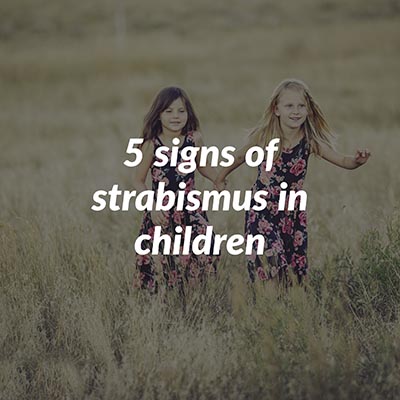5 Signs of Strabismus in Children
Strabismus is an eyesight condition which typically develops in childhood. More commonly known as a squint, walleye or crossed eyes, several factors can cause the condition, including genetic predisposition. Individuals with healthy vision will look at an object with both eyes. The brain will then combine the images from each eye to produce a three-dimensional binocular image.
Binocular vision usually develops in children around the age of seven. However, some children may develop a “lazy” eye that becomes redundant; this can lead to poor sight in that eye and the increasing misalignment of the eyes that characterizes strabismus. Strabismus is also externally visible, so the appearance of their misaligned eyes may cause children to become embarrassed about their looks.
As the child grows, the problem can become entrenched, and treatment of older children carries no guarantee of success. However, strabismus is treatable following an early diagnosis. Here are five signs that a child may be at risk of developing strabismus:
Misaligned Eyes
The most prominent symptom of strabismus is misaligned eyes. The angle of the misalignment may change from convergent to divergent as the child looks at different objects, and the problem may also be intermittent. Because it is often subtle in young children, however, it can be easily missed.
Looking Sideways at Objects
Children with strabismus may turn their heads to help them to focus their dominant eye on things they see. They may also move their heads to each side when viewing objects at different distances.
Closing an Eye
As strabismus develops and the child struggles with their vision, they may close the lazy eye to steady their sight. They may also open and close each eye alternately as they look around. This behavior enables the child to block the image from the lazy eye, causing the problem to become rooted.
Squinting in Moderate Light
Early manifestations of strabismus can cause double vision and headaches, which can be aggravated by light. While children will naturally squint in intense sunlight, children struggling to coordinate their sight may find even mild glare uncomfortable. A child who squints indoors or while looking at a TV screen may be at risk of developing strabismus.
Problems Judging Distance
Binocular vision is a key component in the way we judge depth, so a lack of binocular vision may cause children to act clumsily. Another sign of strabismus is a lack of hand-to-eye coordination. In children, this may cause problems when catching balls during sports and games.
Treatment for strabismus is more likely to be effective if the condition is diagnosed before adolescence. If it is allowed to pass undetected, the child will learn to adapt, but this can damage future job opportunities where good vision is a priority. Treatment for strabismus may involve therapy, but, sometimes, an operation is necessary to realign the eyes.
Screening for strabismus has improved significantly in the last 30 years, and there are fewer cases of strabismus carrying through to adulthood. For this reason, it is imperative that parents seek specialist advice if they spot any symptoms of the condition in their children.

